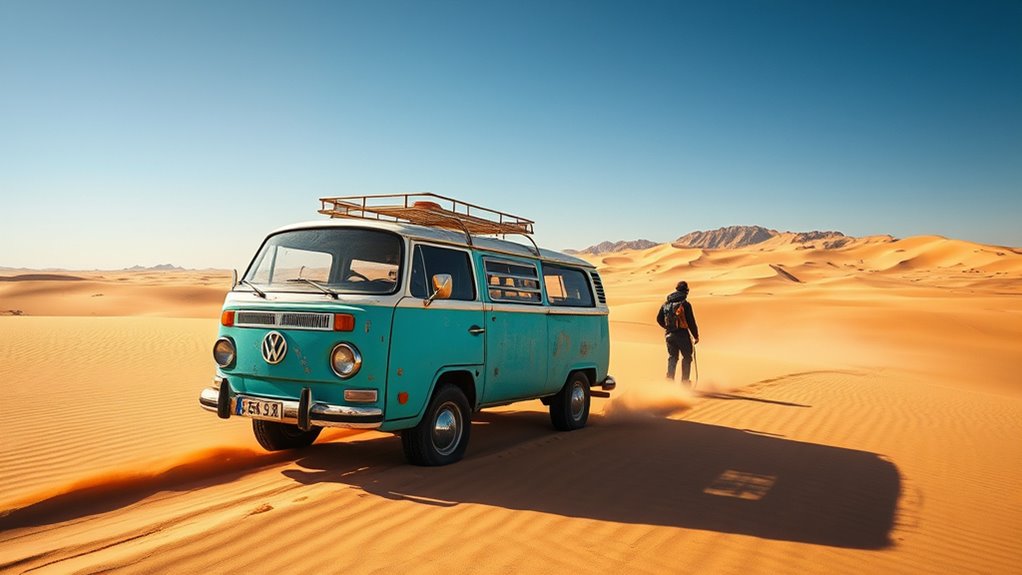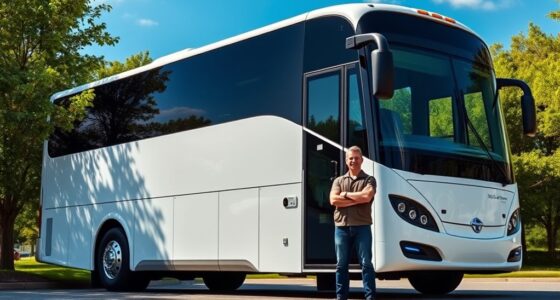To survive a VW bus adventure across the Sahara, you must prioritize meticulous vehicle maintenance—check oil, coolant, and tires regularly—and carry spare parts and tools for repairs. Master navigation with traditional tools like maps and compasses, as GPS can fail in the extreme heat or sandstorms. Stay vigilant, plan your route carefully, and monitor your vehicle’s condition constantly. If you keep these tips in mind, you’ll be better prepared to face the desert’s relentless challenges.
Key Takeaways
- Conduct thorough vehicle maintenance, including checking oil, coolant, and tires, to prevent breakdowns in harsh desert conditions.
- Use traditional navigation tools like maps and compasses, and recognize terrain features to stay on course amid featureless sands.
- Carry spare parts and repair tools for on-the-spot fixes, ensuring vehicle reliability during unexpected breakdowns.
- Plan routes carefully, constantly update your position, and remain vigilant to avoid disorientation and dead ends.
- Prepare for resilience by staying disciplined, resourceful, and maintaining vehicle health to survive the desert’s extreme environment.

Have you ever wondered what it takes to survive in one of the harshest environments on Earth? Traveling across the Sahara in a VW bus pushes you to your limits, demanding constant vigilance and preparation. The vast, scorching desert offers no room for complacency, especially when it comes to vehicle maintenance. Your VW bus becomes more than just transportation; it’s your lifeline. Regular checks of the engine oil, coolant, and tires are vital to avoid breakdowns under the relentless sun. Sand, heat, and dust wear down parts quickly, so you need to stay ahead of potential issues. Carrying spare parts and tools isn’t optional—it’s a safety measure, as repairs can become impossible once you’re miles from help. You must also guarantee your vehicle’s cooling system is functioning perfectly because overheating can happen in a flash, stranding you in the middle of the desert.
Navigation challenges in the Sahara are just as demanding. Unlike city streets or well-mapped roads, the desert’s endless dunes and flat horizons can disorient you easily. With no clear landmarks or signs, you rely heavily on your navigation skills. GPS devices can falter under the intense heat or when signals are blocked by sandstorms, so traditional navigation tools like compasses and detailed maps become invaluable. You’ll need to read the terrain carefully, recognizing subtle features like dune patterns or distant mountain ranges to keep your bearings. Constantly updating your position and planning routes ahead of time helps you avoid dead ends and get closer to your destination. It’s vital to stay vigilant, not just for the next waypoint but also for signs of fatigue or disorientation, which can lead you astray in this vast, featureless landscape. Additionally, understanding vehicle durability and the importance of regular maintenance can significantly improve your chances of success. Staying on course and keeping your vehicle in top shape are intertwined challenges. If your vehicle starts to falter, navigation becomes even more difficult—stopping to fix a breakdown in the desert can be risky, especially during the hottest parts of the day or amidst a sandstorm. That’s why meticulous vehicle maintenance isn’t just about avoiding inconvenience; it’s about your survival. Every mile you cover requires confidence in your vehicle’s reliability. The combination of rigorous maintenance and sharp navigation skills ensures you don’t just survive but can navigate through the Sahara’s brutality with resilience. Preparing for these challenges ahead of time transforms what seems impossible into a daring adventure, where your resourcefulness and discipline keep you moving forward across the endless, unforgiving sands.
Frequently Asked Questions
What Inspired the VW Bus Adventure Across the Sahara?
You’re inspired by the idea of vintage restoration and the thrill of cultural encounters. The adventure across the Sahara pushes you to explore how restoring a classic VW Bus can connect you to history and adventure. This journey fuels your passion for discovering new cultures, embracing challenges, and experiencing the desert’s raw beauty firsthand. It’s about transforming a vintage vehicle into a symbol of resilience and cultural exchange amidst the endless sands.
How Did the Team Prepare for Desert Navigation?
You prepare for desert navigation by studying a detailed desert map and ensuring your navigation tools, like GPS and compasses, are in perfect working order. You plan your route carefully, marking key landmarks and potential hazards. You also practice using your tools in similar conditions, so you can rely on them when visibility drops or signals weaken. This preparation helps you stay on track and avoid dangerous areas in the vast Sahara.
What Were the Biggest Challenges Faced During the Trip?
Ever wonder what truly tests your resilience? During your trip, sandstorms constantly threatened your progress, making visibility nearly impossible and risking your safety. Vehicle breakdowns also posed major hurdles, forcing you to troubleshoot in the scorching heat. These challenges demanded quick thinking and adaptability. Facing unpredictable weather and mechanical issues, you learned that preparation alone isn’t enough — staying calm and resourceful kept you moving forward through the harsh desert environment.
Did the VW Bus Require Modifications for Desert Travel?
You’ll find that the VW bus needed modifications for desert travel, like upgrading to off-road tires for better traction on sand. Additionally, you should verify the engine cooling system is enhanced, preventing overheating under intense desert heat. These adjustments help the vehicle handle rough terrain and extreme temperatures, making your journey safer and more manageable across harsh desert landscapes. Proper preparation is key to overcoming desert challenges with a VW bus.
What Safety Measures Were in Place for Emergencies?
You might think safety measures are unnecessary, but they’re vital in emergencies. You’ve got emergency equipment like first aid kits, water supplies, and spare tires, ensuring you’re prepared for any setbacks. Communication devices, such as satellite phones and radios, keep you connected even in remote areas. These tools give you peace of mind, allowing you to call for help quickly and navigate safely through the harsh desert environment.
Conclusion
As you look back on your Sahara adventure, it’s clear that resilience and preparation are your best allies. Facing endless dunes and scorching heat, you proved that determination can conquer even the harshest environments. So, next time you’re faced with an impossible challenge, ask yourself: isn’t the true victory found in simply surviving and pushing through? After all, some journeys aren’t just about reaching the destination—they’re about discovering what you’re truly capable of.









